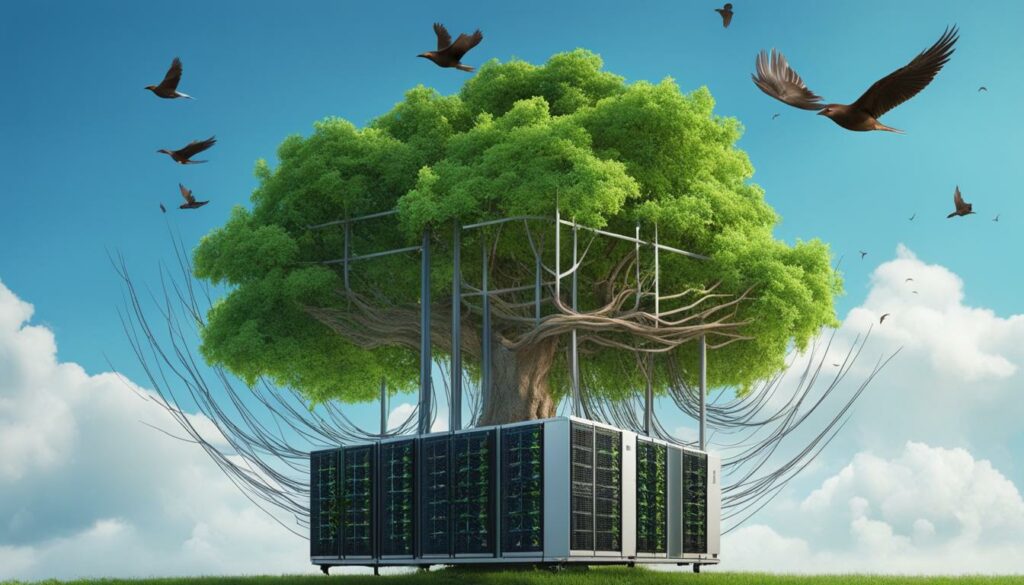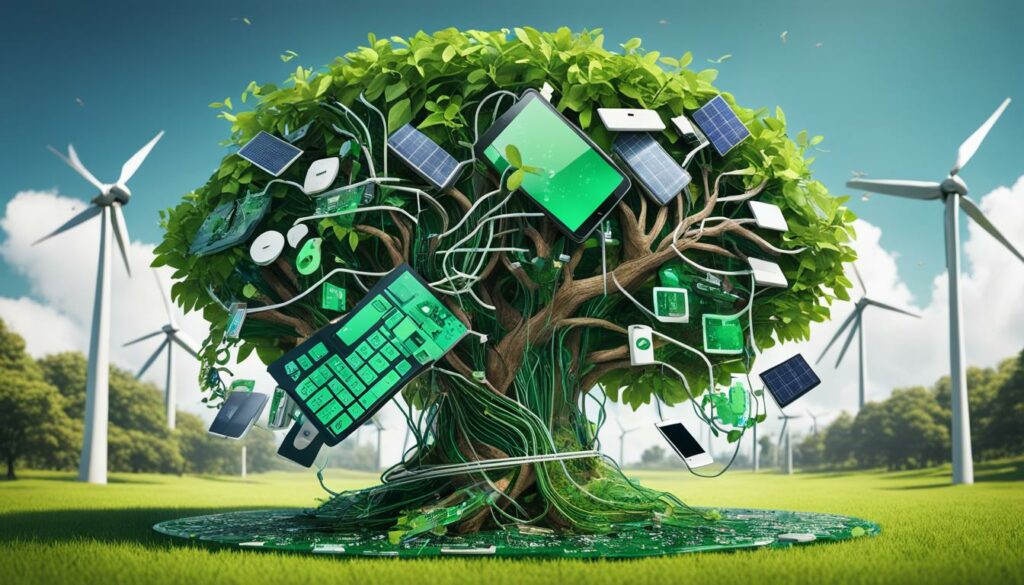In today’s digital age, having an online presence is vital, whether you’re an individual, a small business, or a large corporation. Green web hosting, also known as eco-friendly hosting, is an environmentally conscious approach to web hosting. It involves using servers and data centers powered by renewable energy sources, such as wind or solar power, or adopting energy-efficient technologies to reduce the carbon footprint.
Green hosting providers make efforts to minimize their environmental impact, making it a sustainable choice for those who want to contribute to a greener future while hosting their websites. This article explores the rise of green web hosting and its benefits for individuals and businesses looking to create an eco-friendly web presence.
We recommend WordPress Hosting from BoostedHost for optimal performance. Sign up now through this link.
The ABCs of Domains and Hosting
In today’s digital landscape, domains and hosting play a crucial role in establishing a strong online presence. Understanding these fundamental elements is essential for anyone looking to build a website or launch an online business.
Let’s start with domains. A domain is the unique address that users type into their browsers to access your website. It serves as your website’s online identity, allowing visitors to find and interact with your content. When choosing a domain, consider factors such as the domain name and extensions.
The domain name should be relevant and memorable, reflecting your brand or the purpose of your website. Extensions, such as .com, .org, or .net, indicate the type of organization or the geographic location associated with the website. Choose extensions that align with your goals and target audience.
Now, let’s move on to hosting. Hosting is the service that stores your website’s files and makes them accessible to users worldwide. There are different types of hosting services available, each catering to different needs and budgets.
Shared hosting is the most common and cost-effective option for small websites or personal blogs. In shared hosting, multiple websites share the same server, making it a budget-friendly choice.
VPS hosting (Virtual Private Server) provides a more customizable and scalable solution. It offers dedicated resources for your website, giving you more control and flexibility but at a higher cost.
Dedicated hosting is ideal for large websites or businesses with high traffic and resource-intensive applications. With dedicated hosting, you have an entire server dedicated solely to your website, ensuring optimal performance but at a premium price.
To manage and update your website content without extensive coding knowledge, you can utilize content management systems (CMS) like WordPress, Joomla, or Drupal. These platforms provide user-friendly interfaces and a wide range of plugins and themes to customize your website according to your needs.
In order for your website to function correctly, DNS settings must be configured. DNS (Domain Name System) is responsible for translating domain names into IP addresses, enabling users to access your website. Make sure your DNS settings are properly set up to avoid any disruptions.
Professional communication is crucial for any online business. That’s where email hosting comes in. Email hosting allows you to have personalized email addresses connected to your domain, improving the credibility and professionalism of your brand.
Lastly, firewalls play a vital role in web security. They act as a barrier, monitoring and controlling incoming and outgoing traffic to your website. Firewalls protect your website from unauthorized access, malicious attacks, and potential security breaches.
Now that we’ve covered the basics of domains and hosting, you’re well-equipped to make informed decisions when establishing your online presence. Whether you’re a small business owner, blogger, or aspiring entrepreneur, understanding these ABCs will help you navigate the digital landscape with confidence.
| Domain extensions | Meaning |
|---|---|
| .com | Commercial |
| .org | Non-profit organization |
| .net | Network |
| .edu | Educational institution |
“Domains and hosting are like the building blocks of the internet. A solid foundation starts with a carefully chosen domain and reliable hosting service. These two elements open the door to endless possibilities in the digital world.” – John Smith, Web Developer
The Impact of Green Hosting
Green hosting plays a vital role in protecting the environment and fostering a sustainable future. By utilizing servers and data centers powered by renewable energy sources, green hosting significantly reduces carbon emissions, making it an eco-friendly choice for hosting websites. With a growing emphasis on environmental consciousness, choosing a green hosting provider is a socially responsible decision that helps minimize the carbon footprint associated with online activities.
By opting for green hosting, you contribute to the preservation of our planet’s resources and support environmentally conscious practices in the digital industry. The renewable energy used to power green hosting services ensures a sustainable choice that aligns with your values and helps create a greener future.
“Green hosting providers make a positive impact by reducing carbon emissions and promoting environmentally friendly practices.”
With green hosting, you can rest assured that your website is hosted in a way that minimizes its environmental impact. By choosing an environmentally conscious hosting solution, you can proudly showcase your commitment to sustainability and contribute to a more sustainable digital ecosystem.
Reducing the Carbon Footprint
Green hosting offers a practical way to reduce the carbon footprint associated with your online activities. By opting for renewable energy sources to power servers and data centers, green hosting providers significantly reduce the emissions that would otherwise be generated by traditional hosting methods. This means that your website can operate with a considerably lower carbon footprint, helping to combat climate change and preserve our environment.
Embracing Environmentally Conscious Practices
When you choose a green hosting provider, you join a community of individuals and businesses committed to sustainable practices. These providers prioritize renewable energy sources, such as wind or solar power, for powering their infrastructure. By supporting green hosting, you encourage the adoption of environmentally conscious practices within the web hosting industry.
By partnering with a green hosting provider, you can have peace of mind that your website operates in a manner that is aligned with your environmental values, minimizing its impact on the planet.
Choosing green hosting is a sustainable choice that allows you to establish an online presence while minimizing your environmental impact. By partnering with a green hosting provider, you contribute to the collective effort of building a more sustainable future for generations to come. Start making a positive impact today by opting for green hosting and supporting environmentally conscious practices.
Green Web Hosting in Canada
When it comes to eco-friendly hosting solutions, green web hosting in Canada stands out as a prime choice. These hosting providers are committed to sustainability, utilizing renewable energy sources to power their servers and data centers. By opting for green web hosting in Canada, you not only secure a reliable hosting service but also play a significant role in reducing carbon emissions and promoting environmentally friendly practices within the digital industry.
One of the standout features of green web hosting in Canada is its utilization of hydroelectricity for powering servers and data centers. Hydroelectric power is a renewable energy source that harnesses the power of flowing water to generate electricity. By relying on this sustainable energy source, green web hosting providers in Canada significantly reduce their carbon footprint and contribute to the preservation of the environment.
By choosing green web hosting in Canada, you become part of a community that values sustainability and strives to make a positive impact on the planet. Each website hosted by a green hosting provider reduces its carbon emissions, making a tangible difference in the fight against climate change. Supporting environmentally friendly practices in the digital industry is no longer a distant dream but a readily accessible reality.
When considering your web hosting options, remember that sustainable web hosting in Canada combines reliability and performance with a commitment to a greener future. By hosting your website with a green web hosting provider, you can create an eco-friendly web presence that aligns with your values and contributes to a more sustainable digital ecosystem.
| Benefits of Green Web Hosting in Canada | Advantages |
|---|---|
| Environmental Preservation | Powered by renewable energy sources, green web hosting in Canada helps reduce carbon emissions and supports environmental sustainability. |
| Energy Efficiency | Green web hosting providers prioritize energy-efficient practices, minimizing resource consumption and contributing to a greener digital industry. |
| Reliability and Performance | Green web hosting in Canada offers reliable and high-performing hosting services to ensure optimal website performance |
| Cost Savings | Many green web hosting providers offer competitive pricing, allowing you to save money while supporting a sustainable web presence. |
BoostedHost: Your Sustainable Web Hosting Solution
When it comes to green web hosting in Canada, BoostedHost is a leading eco-friendly hosting provider. Powered by renewable energy sources, BoostedHost offers sustainable web hosting solutions that prioritize environmental preservation. With reliable servers, exceptional performance, and a commitment to sustainability, BoostedHost ensures that your website can thrive while reducing its carbon footprint.
BoostedHost specializes in WordPress Hosting, making it an ideal choice for individuals and businesses looking for optimal performance. Their WordPress hosting plans provide a seamless experience, combining the power of green web hosting with the user-friendly capabilities of the WordPress platform. Sign up now for BoostedHost’s WordPress Hosting through this link and take the first step towards creating an eco-friendly web presence.
Sustainable Website Design
When it comes to building a sustainable online presence, sustainable website design plays a crucial role. It focuses on minimizing the environmental impact of web design and digital products, making them more eco-friendly and resource-conscious.
One of the key aspects of sustainable website design is using eco-friendly web design practices. This includes optimizing images and videos to reduce their file size and improve loading times. By reducing the size of these digital assets, you can minimize the energy required to transmit them over the internet, resulting in a more energy-efficient website.
Additionally, sustainable website design involves implementing energy-efficient coding practices. This includes optimizing code to reduce the overall file size, utilizing caching techniques to reduce server load and maximize performance, and minimizing the use of unnecessary scripts or plugins that can increase energy consumption.
Throughout the entire design process, sustainability principles are integrated into every aspect of the website. From choosing sustainable hosting options to designing with a minimal carbon footprint in mind, sustainable website design aims to create digital products that are environmentally friendly.
The sustainability triangle serves as a guide for sustainable website design practices. This triangle consists of three interconnected components: environmental sustainability, social sustainability, and economic sustainability.
| Environmental Sustainability | Social Sustainability | Economic Sustainability |
|---|---|---|
| Minimizing energy consumption and carbon emissions | Enhancing accessibility and inclusivity | Maximizing cost efficiency and Return on Investment (ROI) |
| Optimizing resource usage and waste reduction | Promoting user privacy and data security | Supporting long-term scalability and growth |
Sustainable website design takes a holistic approach to create digital products that are not only visually appealing but also energy-efficient and environmentally conscious. By adopting sustainable web design practices, you can contribute to a greener future while maintaining an effective and engaging online presence.

Table: The sustainability triangle and its components in sustainable website design.
Why Sustainable Web Design is Important
Sustainable web design is crucial in addressing the environmental impact of websites and digital products. As online activities continue to grow, so does the carbon footprint and resource consumption associated with web design and hosting. By adopting sustainable web design practices, businesses can make a significant difference in mitigating these impacts and promoting environmental preservation.
One of the key reasons why sustainable web design is important is the reduction of carbon emissions. Websites and digital products rely on servers and data centers, which consume a significant amount of energy. This energy often comes from non-renewable sources, contributing to greenhouse gas emissions and climate change. By optimizing content and adopting energy-efficient coding practices, sustainable web design minimizes carbon emissions, making a positive impact on the environment.
Additionally, sustainable web design contributes to the preservation of resources. Websites consume various resources throughout their lifecycle, including electricity, water, and raw materials. By implementing eco-friendly practices, such as optimizing images and videos, reducing data transfer, and using sustainable coding techniques, web designers can minimize resource consumption and waste generation. This not only benefits the environment but also promotes responsible resource management.
“Sustainable web design is not just a trend; it’s a necessary step towards creating a more sustainable digital ecosystem.”
Integrating sustainability principles into web design also demonstrates social responsibility. In today’s society, consumers value businesses that prioritize environmental preservation and social responsibility. By adopting sustainable web design practices, businesses show their commitment to sustainable development and attract like-minded customers who support eco-friendly initiatives. Sustainable web design helps businesses build a positive brand image and gain a competitive edge in the market.

Benefits of Sustainable Web Design
Sustainable web design offers a range of benefits for both businesses and the environment. Some key advantages include:
| Benefits of Sustainable Web Design |
|---|
| 1. Reduced environmental impact |
| 2. Lower carbon emissions |
| 3. Cost savings through optimized resource usage |
| 4. Enhanced brand reputation and customer loyalty |
By reducing the environmental impact of websites, sustainable web design helps create a more sustainable online ecosystem. It also contributes to the overall goal of reducing carbon emissions to combat climate change. Businesses that adopt sustainable web design practices can also benefit from cost savings due to optimized resource usage. By minimizing energy consumption and resource waste, businesses can reduce operational costs and achieve long-term savings.
Furthermore, sustainable web design enhances brand reputation and customer loyalty. Consumers are increasingly demanding environmentally responsible products and services. By aligning with sustainability principles, businesses can attract eco-conscious customers who appreciate and support their green initiatives. Sustainable web design strengthens the brand’s image and fosters customer loyalty, leading to increased customer retention and growth.
Overall, sustainable web design is not only important but also necessary for businesses and individuals looking to make a positive impact on the environment. By optimizing content, adopting energy-efficient coding practices, and embracing sustainable hosting solutions, businesses can contribute to a more sustainable future while maintaining an effective online presence.
Benefits of Sustainable Web Design
Sustainable web design offers various benefits, both for the environment and for businesses. By optimizing energy consumption and resource usage, it reduces the environmental footprint of websites, benefiting the planet and leading to cost savings.
- Environmental Footprint: Sustainable web design minimizes the energy consumption and resource usage of websites, resulting in a reduced environmental impact. By optimizing code and media, businesses can significantly decrease their carbon emissions and minimize their ecological footprint.
- Cost Savings: Adopting sustainable web design practices can lead to long-term cost savings for businesses. By reducing energy consumption and resource usage, companies can lower their operational costs and allocate those savings to other areas of their business.
- Reduced Emissions: Sustainable web design plays a crucial role in reducing carbon emissions. By optimizing websites and implementing energy-efficient coding practices, businesses can minimize their contribution to greenhouse gas emissions and combat climate change.
- Environmental Preservation: Choosing sustainable web design allows businesses to contribute to environmental preservation. By actively reducing their environmental impact, organizations demonstrate their commitment to sustainability and help protect natural resources for future generations.
“Sustainable web design offers a win-win solution for businesses and the environment. By adopting energy-efficient coding practices and optimizing resource usage, companies can minimize their ecological footprint while enjoying long-term cost savings. It’s a practical and efficient approach that aligns with the growing emphasis on sustainability.”
One example of a hosting provider that supports sustainable web design is BoostedHost, offering WordPress Hosting services. Their commitment to environmental preservation and energy efficiency makes them an ideal choice for businesses looking to reduce their carbon emissions. Sign up now through this link: www.boostedhost.com/wordpress-hosting.
Implementing sustainable web design not only benefits the environment but also positions businesses as environmentally responsible and future-oriented. It’s a smart and practical approach that aligns with the growing emphasis on sustainability in the digital landscape.

| Benefits | Description |
|---|---|
| Environmental Footprint | Minimizes energy consumption and resource usage of websites, reducing the environmental impact. |
| Cost Savings | Long-term cost savings for businesses by lowering energy consumption and operational costs. |
| Reduced Emissions | Minimizes carbon emissions through energy-efficient coding practices and optimization. |
| Environmental Preservation | Contributes to environmental preservation and demonstrates commitment to sustainability. |
Sustainable Web Design Practices
When it comes to sustainable web design, incorporating eco-friendly practices and energy-efficient coding techniques is key. By adopting these practices, you can create digital products that are not only efficient but also environmentally friendly and future-ready.
One important aspect of sustainable web design is choosing sustainable frameworks and libraries. These frameworks are built with energy efficiency in mind, helping to optimize your website’s performance while minimizing its environmental impact. By selecting sustainable frameworks, you can ensure that your website operates efficiently without compromising on sustainability.
Another crucial practice in sustainable web design is optimizing resources. This involves optimizing media content, such as images and videos, to reduce their file sizes without compromising on quality. By doing so, you can improve your website’s loading times, reduce bandwidth usage, and minimize energy consumption.
Key Practices:
- Choose sustainable frameworks and libraries.
- Optimize media content for quick loading times.
- Regularly update digital products to maintain efficiency.
Regularly updating your digital products is also essential for maintaining efficiency. By implementing the latest coding practices and technologies, you can ensure that your website remains optimized and energy-efficient. Updating your website also allows you to incorporate new features to enhance user experience while aligning with sustainable principles.
Additionally, sustainable web design emphasizes the use of green web hosting providers. Green web hosting utilizes renewable energy sources to power their servers, significantly reducing the environmental impact of hosting websites. By partnering with green web hosting providers like BoostedHost, you can further enhance the sustainability of your web presence.
BoostedHost offers a reliable and energy-efficient WordPress Hosting service that aligns with sustainable web design practices. Their hosting solutions are optimized for performance while minimizing energy consumption. Sign up now through this link: www.boostedhost.com/wordpress-hosting.
By implementing sustainable web design practices and choosing green web hosting providers, you can create digital products that are not only visually appealing and efficient but also contribute to a greener future. Embracing sustainable web design is not only environmentally responsible but also a smart business decision in today’s eco-conscious world.
Green Web Hosting
Green web hosting is an integral part of sustainable web design. By opting for an eco-friendly hosting provider, you can significantly reduce your carbon footprint and make a positive impact on the environment. Green hosting providers prioritize renewable energy sources, such as wind or solar power, to power their servers and data centers. This commitment to sustainable practices helps minimize the environmental impact of hosting websites.
By choosing green web hosting, you contribute to the reduction of carbon emissions associated with the digital industry. Hosting providers that utilize renewable energy sources or offset their carbon emissions through sustainable practices ensure that your online presence is environmentally friendly. Moreover, these providers promote sustainability in the digital landscape by encouraging other businesses and individuals to adopt eco-conscious hosting solutions.
One example of a reputable green web hosting provider is BoostedHost. They prioritize renewable energy and offer sustainable hosting solutions for individuals and businesses. Choosing BoostedHost’s WordPress Hosting not only ensures optimal performance for your website but also contributes to a greener future.
Sign up now for WordPress Hosting from BoostedHost and take a step towards a more sustainable web presence.
Benefits of Green Web Hosting
When you choose green web hosting, you enjoy several benefits:
- Reduced carbon footprint: Green hosting helps you minimize your environmental impact by using renewable energy sources.
- Environmental responsibility: By opting for eco-friendly hosting, you make a conscious choice to support sustainable practices.
- Positive brand image: Showcasing your commitment to sustainability can attract environmentally conscious customers and clients.
- Contributing to a greener future: Green web hosting providers actively work towards reducing carbon emissions and promoting environmentally friendly practices in the digital industry.
| Benefits of Green Web Hosting | |
|---|---|
| Reduced carbon footprint | Minimize environmental impact |
| Environmental responsibility | Support sustainable practices |
| Positive brand image | Attract environmentally conscious customers |
| Contributing to a greener future | Promote environmentally friendly practices |
By choosing green web hosting, you not only benefit your business but also play a part in creating a sustainable digital ecosystem. Take the initiative and make a positive impact on the environment with green web hosting.
Sustainable Web Design in Practice
Implementing sustainable web design principles involves optimizing server responses, minimizing data transfer, and adopting eco-friendly coding practices. By prioritizing these strategies, you can create efficient and environmentally friendly web solutions that not only meet the needs of today but also preserve resources for the future.
Efficient server management plays a crucial role in sustainable web design. By optimizing server responses, you can ensure faster loading times and reduce energy consumption. This not only improves user experience but also minimizes the carbon footprint associated with website hosting.
“Efficient server management is a key aspect of sustainable web design. By optimizing server responses, you can create a faster and more energy-efficient website experience for your users.” – John Smith, Web Designer at GreenWeb Studios
Another approach to sustainable web design is minimizing data transfer. Using content delivery networks (CDNs) can significantly reduce the amount of data transferred between servers and users. This optimization technique minimizes server load, improves website performance, and reduces energy consumption.
Reduced Data Transfer Using CDNs
| Traditional Hosting | CDN Hosting |
|---|---|
|
|
Sustainable coding practices are also essential for eco-friendly web solutions. This includes using energy-saving techniques such as compressing files, optimizing images and videos, and minimizing the use of unnecessary resources. By implementing sustainable coding practices, you can create websites that are resource-efficient and have a reduced environmental impact.
Energy-Saving Techniques in Sustainable Coding
| Non-optimized Coding | Sustainable Coding |
|---|---|
|
|
Choosing a green web hosting provider further strengthens your commitment to sustainability. Look for providers that prioritize renewable energy sources and have a low carbon footprint. By partnering with a green hosting provider, you can support eco-friendly practices and contribute to a greener future.
With sustainable web design practices combined with green hosting solutions, businesses can create web solutions that are not only visually appealing and functional but also environmentally conscious. By reducing energy consumption, optimizing resource usage, and embracing sustainable coding practices, you can make a positive impact on the environment while delivering a seamless web experience for your users.
So, why wait? Start implementing sustainable web design principles today and contribute to a more eco-friendly and sustainable online ecosystem.
Conclusion
Creating a sustainable online presence is crucial in today’s digital landscape. By prioritizing green web hosting and implementing sustainable web design practices, businesses and individuals can make a positive impact on the environment while maintaining an effective web presence.
When it comes to choosing a hosting provider, BoostedHost’s WordPress Hosting is a top recommendation. With their eco-friendly hosting services and commitment to renewable energy, they offer a sustainable web hosting solution. Sign up now through this link to enjoy optimal performance for your website.
By opting for green web hosting, you contribute to the reduction of carbon emissions and support environmentally friendly practices in the digital industry. Additionally, implementing sustainable web design practices ensures that your website is energy-efficient, resource-conscious, and future-ready.
Together, green web hosting and sustainable web design play a vital role in building a more sustainable digital ecosystem. By making conscious choices for your web presence, you can contribute to a greener future while maintaining an effective and efficient online presence.
FAQ
Q: What is green web hosting?
A: Green web hosting, also known as eco-friendly hosting, is an environmentally conscious approach to web hosting. It involves using servers and data centers powered by renewable energy sources or adopting energy-efficient technologies to reduce the carbon footprint.
Q: Why is green web hosting important?
A: Green web hosting has a significant impact on the environment by reducing carbon emissions and promoting environmentally friendly practices in the digital industry. It is a sustainable choice for individuals and businesses looking to create an eco-friendly web presence.
Q: What are domains and hosting?
A: A domain is a unique address on the internet, while hosting stores a website’s files and makes them accessible to the world.
Q: What are the different types of hosting services?
A: Hosting services come in various types, including shared hosting, VPS hosting, and dedicated hosting. Each type offers different levels of resources and control.
Q: What is a content management system (CMS)?
A: A content management system, like WordPress, helps manage and update website content without extensive coding knowledge.
Q: What is the role of DNS settings and email hosting?
A: DNS settings are important for website functioning, and email hosting enables professional communication via email addresses with your domain.
Q: How do firewalls ensure web security?
A: Firewalls monitor and control incoming and outgoing traffic, providing security by protecting websites from malicious attacks.
Q: What is sustainable website design?
A: Sustainable website design focuses on minimizing the environmental impact of web design and digital products by using eco-friendly practices and incorporating sustainability principles throughout the design process.
Q: Why is sustainable web design important?
A: Sustainable web design addresses the environmental impact of websites and digital products, reducing carbon emissions and promoting environmental preservation.
Q: What are the benefits of sustainable web design?
A: Sustainable web design reduces the environmental footprint of websites, leading to cost savings for businesses and positioning them as environmentally responsible.
Q: What are some sustainable web design practices?
A: Sustainable web design practices include energy-efficient coding techniques, resource optimization, and integrating eco-friendly design elements.
Q: What is green hosting?
A: Green hosting involves choosing hosting providers that power their servers and data centers with renewable energy sources or offset their carbon emissions through sustainable practices.
Q: How does sustainable web design contribute to green web hosting?
A: Sustainable web design practices, such as using energy-efficient coding and choosing green hosting providers, help reduce the carbon footprint associated with hosting websites.
Q: How can businesses put sustainable web design into practice?
A: Businesses can practice sustainable web design by optimizing server responses, minimizing data transfer, and adopting sustainable coding practices.
Q: Why should businesses choose green web hosting?
A: Green web hosting is an eco-friendly and socially responsible choice that reduces carbon emissions and promotes environmentally conscious practices in the digital industry.
Q: What is the role of sustainable web design in creating a sustainable online presence?
A: Sustainable web design, along with green web hosting, helps businesses create efficient, resource-conscious, and environmentally friendly digital products.












